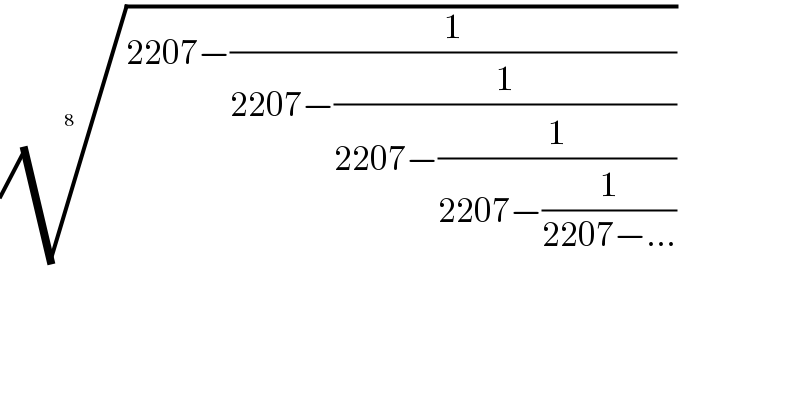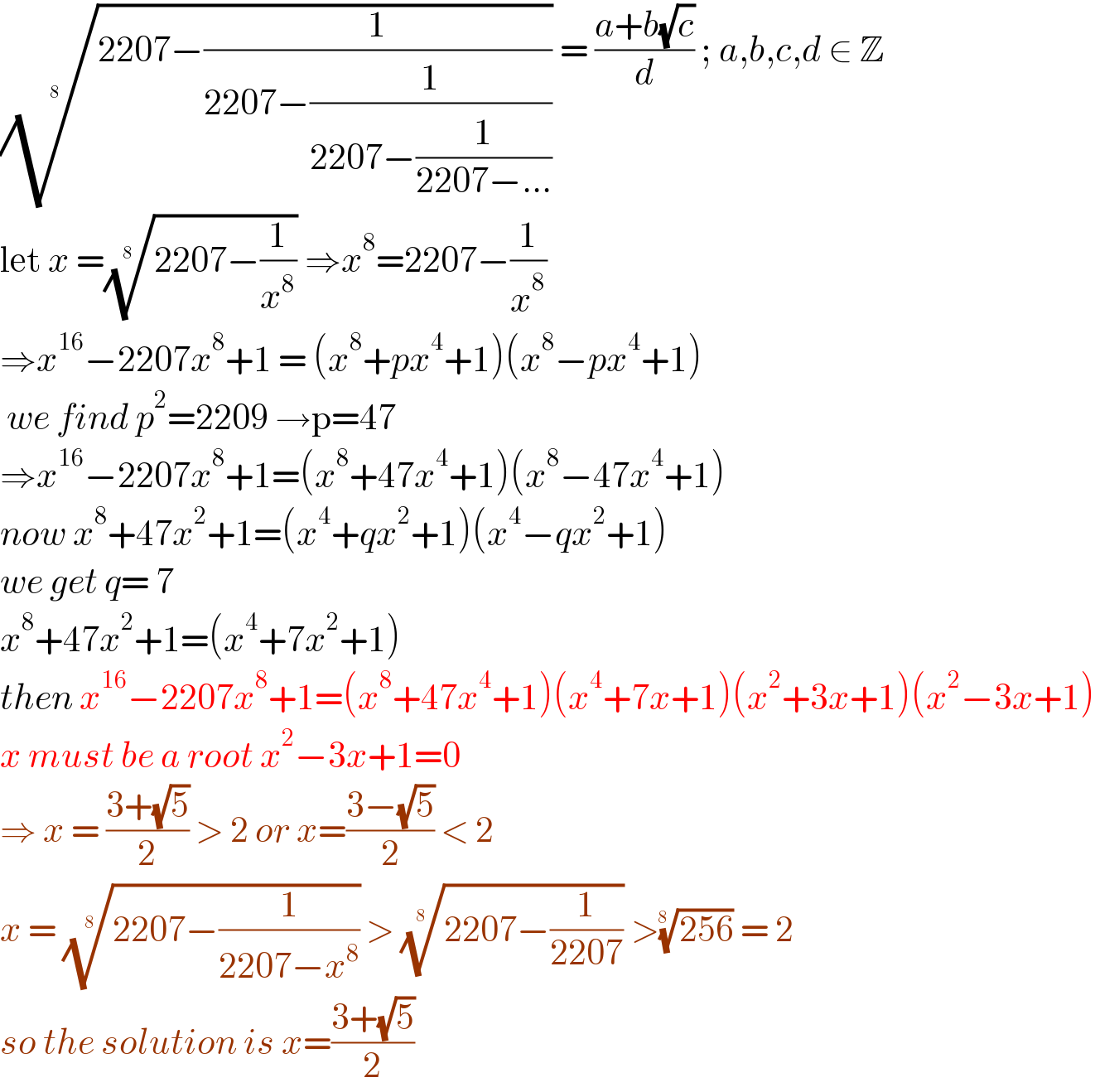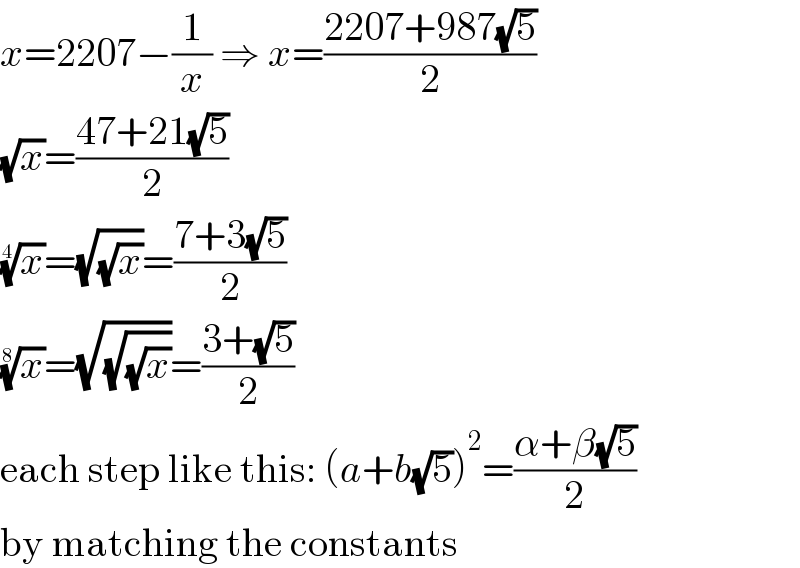Question Number 128264 by bobhans last updated on 06/Jan/21

$$\sqrt[{\mathrm{8}\:\:\:\:}]{\mathrm{2207}−\frac{\mathrm{1}}{\mathrm{2207}−\frac{\mathrm{1}}{\mathrm{2207}−\frac{\mathrm{1}}{\mathrm{2207}−\frac{\mathrm{1}}{\mathrm{2207}−…}}}}} \\ $$
Commented by MJS_new last updated on 06/Jan/21

$$\frac{\mathrm{3}+\sqrt{\mathrm{5}}}{\mathrm{2}} \\ $$
Commented by bobhans last updated on 06/Jan/21

$${waw}….{how}? \\ $$
Commented by liberty last updated on 06/Jan/21

$$\sqrt[{\mathrm{8}\:}]{\mathrm{2207}−\frac{\mathrm{1}}{\mathrm{2207}−\frac{\mathrm{1}}{\mathrm{2207}−\frac{\mathrm{1}}{\mathrm{2207}−…}}}}\:=\:\frac{{a}+{b}\sqrt{{c}}}{{d}}\:;\:{a},{b},{c},{d}\:\in\:\mathbb{Z} \\ $$$$\mathrm{let}\:{x}\:=\sqrt[{\mathrm{8}\:}]{\mathrm{2207}−\frac{\mathrm{1}}{{x}^{\mathrm{8}} }}\:\Rightarrow{x}^{\mathrm{8}} =\mathrm{2207}−\frac{\mathrm{1}}{{x}^{\mathrm{8}} } \\ $$$$\Rightarrow{x}^{\mathrm{16}} −\mathrm{2207}{x}^{\mathrm{8}} +\mathrm{1}\:=\:\left({x}^{\mathrm{8}} +{px}^{\mathrm{4}} +\mathrm{1}\right)\left({x}^{\mathrm{8}} −{px}^{\mathrm{4}} +\mathrm{1}\right) \\ $$$$\:{we}\:{find}\:{p}^{\mathrm{2}} =\mathrm{2209}\:\rightarrow\mathrm{p}=\mathrm{47} \\ $$$$\Rightarrow{x}^{\mathrm{16}} −\mathrm{2207}{x}^{\mathrm{8}} +\mathrm{1}=\left({x}^{\mathrm{8}} +\mathrm{47}{x}^{\mathrm{4}} +\mathrm{1}\right)\left({x}^{\mathrm{8}} −\mathrm{47}{x}^{\mathrm{4}} +\mathrm{1}\right) \\ $$$${now}\:{x}^{\mathrm{8}} +\mathrm{47}{x}^{\mathrm{2}} +\mathrm{1}=\left({x}^{\mathrm{4}} +{qx}^{\mathrm{2}} +\mathrm{1}\right)\left({x}^{\mathrm{4}} −{qx}^{\mathrm{2}} +\mathrm{1}\right) \\ $$$${we}\:{get}\:{q}=\:\mathrm{7} \\ $$$${x}^{\mathrm{8}} +\mathrm{47}{x}^{\mathrm{2}} +\mathrm{1}=\left({x}^{\mathrm{4}} +\mathrm{7}{x}^{\mathrm{2}} +\mathrm{1}\right) \\ $$$${then}\:{x}^{\mathrm{16}} −\mathrm{2207}{x}^{\mathrm{8}} +\mathrm{1}=\left({x}^{\mathrm{8}} +\mathrm{47}{x}^{\mathrm{4}} +\mathrm{1}\right)\left({x}^{\mathrm{4}} +\mathrm{7}{x}+\mathrm{1}\right)\left({x}^{\mathrm{2}} +\mathrm{3}{x}+\mathrm{1}\right)\left({x}^{\mathrm{2}} −\mathrm{3}{x}+\mathrm{1}\right) \\ $$$${x}\:{must}\:{be}\:{a}\:{root}\:{x}^{\mathrm{2}} −\mathrm{3}{x}+\mathrm{1}=\mathrm{0} \\ $$$$\Rightarrow\:{x}\:=\:\frac{\mathrm{3}+\sqrt{\mathrm{5}}}{\mathrm{2}}\:>\:\mathrm{2}\:{or}\:{x}=\frac{\mathrm{3}−\sqrt{\mathrm{5}}}{\mathrm{2}}\:<\:\mathrm{2} \\ $$$${x}\:=\:\sqrt[{\mathrm{8}}]{\mathrm{2207}−\frac{\mathrm{1}}{\mathrm{2207}−{x}^{\mathrm{8}} }}\:>\:\sqrt[{\mathrm{8}\:}]{\mathrm{2207}−\frac{\mathrm{1}}{\mathrm{2207}}}\:>\sqrt[{\mathrm{8}\:}]{\mathrm{256}}\:=\:\mathrm{2} \\ $$$${so}\:{the}\:{solution}\:{is}\:{x}=\frac{\mathrm{3}+\sqrt{\mathrm{5}}}{\mathrm{2}} \\ $$
Answered by MJS_new last updated on 06/Jan/21

$${x}=\mathrm{2207}−\frac{\mathrm{1}}{{x}}\:\Rightarrow\:{x}=\frac{\mathrm{2207}+\mathrm{987}\sqrt{\mathrm{5}}}{\mathrm{2}} \\ $$$$\sqrt{{x}}=\frac{\mathrm{47}+\mathrm{21}\sqrt{\mathrm{5}}}{\mathrm{2}} \\ $$$$\sqrt[{\mathrm{4}}]{{x}}=\sqrt{\sqrt{{x}}}=\frac{\mathrm{7}+\mathrm{3}\sqrt{\mathrm{5}}}{\mathrm{2}} \\ $$$$\sqrt[{\mathrm{8}}]{{x}}=\sqrt{\sqrt{\sqrt{{x}}}}=\frac{\mathrm{3}+\sqrt{\mathrm{5}}}{\mathrm{2}} \\ $$$$\mathrm{each}\:\mathrm{step}\:\mathrm{like}\:\mathrm{this}:\:\left({a}+{b}\sqrt{\mathrm{5}}\right)^{\mathrm{2}} =\frac{\alpha+\beta\sqrt{\mathrm{5}}}{\mathrm{2}} \\ $$$$\mathrm{by}\:\mathrm{matching}\:\mathrm{the}\:\mathrm{constants} \\ $$
Commented by mr W last updated on 06/Jan/21

$${can}\:{we}\:{and}\:{should}\:{we}\:{get}\:{two}\:{possible} \\ $$$${solutions}\:\frac{\mathrm{3}\pm\sqrt{\mathrm{5}}}{\mathrm{2}}? \\ $$
Commented by MJS_new last updated on 06/Jan/21

$$\mathrm{2207}−\frac{\mathrm{1}}{\mathrm{2207}}\approx\mathrm{2207} \\ $$$${x}=\mathrm{2207}−\frac{\mathrm{1}}{{x}}\:\Rightarrow\:{x}\approx\mathrm{2207}\vee{x}\approx\frac{\mathrm{1}}{\mathrm{2207}} \\ $$$$\Rightarrow\:\mathrm{only}\:\mathrm{one}\:\mathrm{solution} \\ $$
